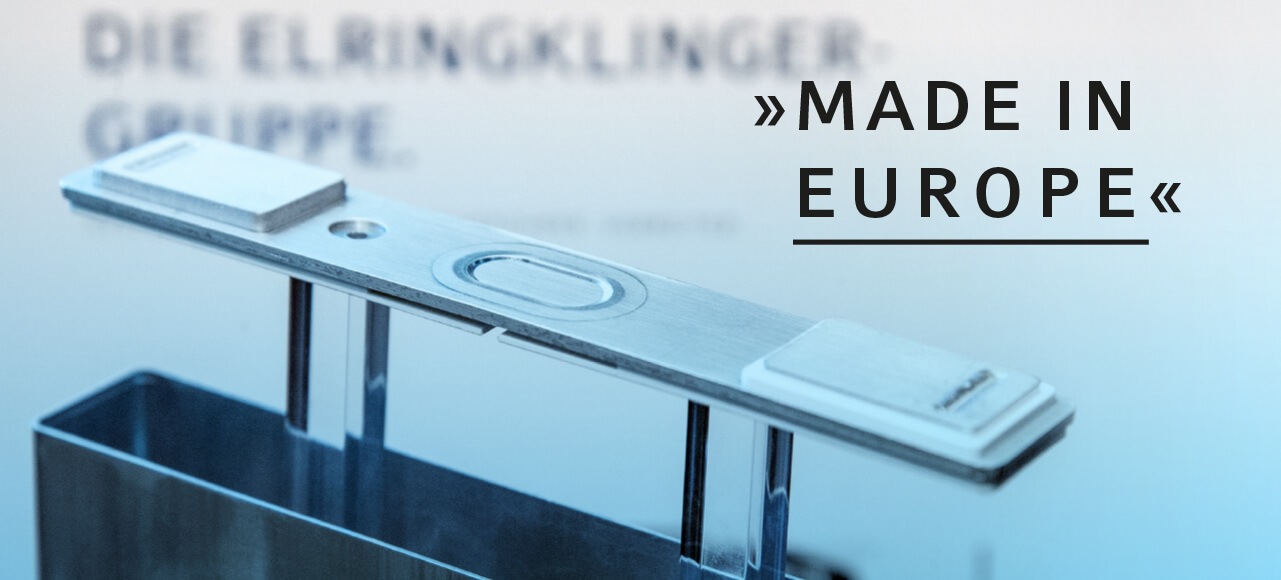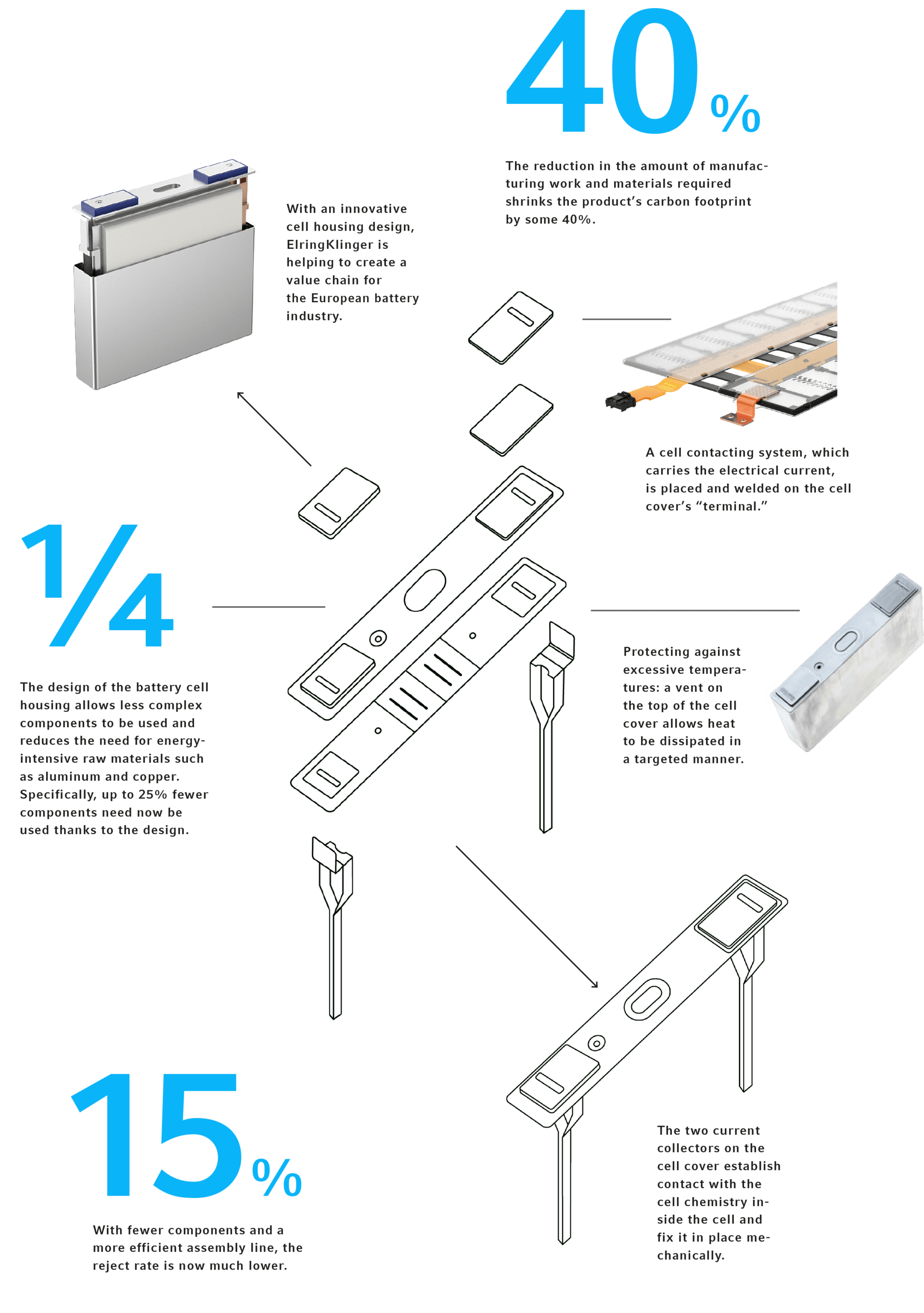
Made in Europe
ElringKlinger is part of a major international project to build a value chain for the European battery industry. The aim of creating a battery “made in Europe” is to improve competitiveness and skills in the EU, drive forward sustainability, and reduce dependence on non-member states. Highly innovative technologies and techniques that go beyond the current state of the art are being funded as part of the battery IPCEIs (Important Projects of Common European Interest).
The cell cover ensures that power is transmitted into and out of the cell via its poles. Together with the cell cup, the cell cover encloses the battery cell.
Asia is the dominant player on the scene, with the ten largest manufacturers of automotive battery storage systems being Asian companies. Between them, they held a market share of over 90% in 2022 according to the South Korean market research institute SNE Research. This figure alone highlights how dependent the automotive industry is on the region for its electric-vehicle batteries. Not only the economic fallout from the coronavirus pandemic but also shifts in the geopolitical landscape are increasingly pushing issues such as the resilience of supply chains and dependencies in the case of critical raw materials to the forefront of public debate.
European companies also have the expertise required to build batteries for electric cars, yet not one of them is among the world’s biggest battery manufacturers. So how can one go about ensuring that Europe, too, has a value chain in place for this key technology of the future? The large-scale IPCEIs are designed to develop core technologies such as semiconductor, battery, and fuel cell technology on the European continent, while the two battery IPCEIs are also aiming to reduce dependency and improve security of supply.
The European Commission approved the second IPCEI for battery technology in 2021. This project, entitled “European Battery Innovation” (or “EuBatIn” for short), is being coordinated by Germany and will see a total of 12 EU countries contribute up to EUR 2.9 billion to the development of a European battery value chain. ElringKlinger is one of only 13 German companies to obtain funding of this kind as part of the EuBatIn program. This major international funding project is geared toward building a closed, sustainable, and innovative value chain for lithium-ion battery technology in the EU. It has deliberately adopted a holistic approach that encompasses the entire value chain: from obtaining and producing the materials, manufacturing the cells, and assembling the modules and systems right through to creating the product and recycling it.
ElringKlinger is also involved in this IPCEI and has been awarded funding totaling EUR 33.8 million for an innovative battery cell housing design to be provided by the German Federal Ministry for Economic Affairs and Energy and the state of Baden-Württemberg by the end of 2026. One unique feature of the IPCEI program is that the funding will also support the journey to series production, thus extending well beyond the scope of many other funding schemes. In order to secure its funding, ElringKlinger had to ensure that its proposed project and the related processes met various requirements. That was not all, however: a particularly innovative technical approach was also required in order to stand out.

As its name suggests, the second battery IPCEI – “EuBatIn” – is very much about innovation. With this in mind, the engineers at ElringKlinger focused specifically on furthering the development of its battery cell cover, a vital component of the battery cell. Their development efforts produced a cell cover design that, in technical terms, outperforms current sealing components in many respects. The members of ElringKlinger’s battery technology team at its Neuffen site are working on the component in a project officially entitled “Entwicklung und Industrialisierung eines innovativen Batteriezellgehäusedesigns für verschiedene Zellformate” (i. e., the development and industrialization of an innovative battery cell housing design for various cell formats). The Group developed the innovative cell cover for use on both prismatic and cylindrical (round) cells. ElringKlinger’s engineers began tackling the cell housing right from an early stage, because it is on the cover, i.e., the lid, that another key component is placed and welded – the cell contacting system, which carries the electrical current and monitors voltage and temperature. The Group is putting its expertise in metal forming and punching technology to good use in the production of the metallic cell connectors that are fitted inside the cell contacting system. ElringKlinger has been mass-producing cell contacting systems and supplying them to customers for over ten years now. The series production of cell contacting systems is another element in the Group’s ongoing transformation.
Electrifying
Market forecasts by S&P Global Mobility suggest that over half the passenger cars and light commercial vehicles produced in Europe in 2029 will be battery-electric ones.
But back to the cell housing. As the diagram below shows, the two current collectors are fed through several openings before being welded to the “terminal” when the cell housing cover is fitted. An innovative sealant containing casting compound is used for this purpose, while the geometries of the individual parts have also been simplified considerably. The developers have thus saved on costly and resource-intensive components as well as reducing the number of welding operations required on the cell cover by 75%. Before they had even finished writing their first proposal, the members of the project team were confident that this relatively small component would definitely be able to achieve great things. Ultimately, the design also paves the way for a more streamlined production concept with far fewer production steps.
"We’ve been able to do away with up to a quarter of the components. With fewer parts and an efficient production concept, the reject rate is also much lower.“
Gunnar Deichmann, Vice President Battery Technology
The cover of a cell housing has to meet many different requirements in the product specifications – perfectly. Insulating and connecting are two of the key functions that ensure, for example, that humidity (from outside) and the cell chemistry (on the inside) cannot react with each other. At the same time, electrical energy has to be supplied and conducted away via the cell poles. For this, a direct connection is established between the two current collectors on the cell cover, made from aluminum and copper, and the cell chemistry – the active part of the cell. The current collectors also come into contact with the cell chemistry and fix it in place inside the cell. However, there are other safety-related tasks that the cell cover has to master too: as well as shielding the cell chemistry from external influences (such as air and moisture), it also has to make sure that the environment is protected against the hazardous components inside the cell. In addition, the vent on top of the cell cover gives the cell a form of self-protection should it overheat or expand excessively, for instance.
ElringKlinger’s innovative cell cover is also a boon for sustainability in several respects. First of all, its design enables up to 25% fewer components to be used. Besides being expensive, the components that are no longer needed also use up a lot of material and energy. The product’s carbon footprint can be shrunk by around 40% in total, mainly thanks to the simpler production process – which uses only a quarter of the welding operations that used to be required – and the improved product design. The funding program is also facilitating progress on the sustainability front at an overarching, European level. The efforts to build a battery value chain in Europe are most definitely also linked to a desire to create new jobs on the continent in this highly attractive segment, ranging from the raw material through to production and recycling. There are over 40 companies from 12 EU member states working on the future of the European battery in four “workstreams.” A conscious decision has been made to integrate battery recycling into the framework for this holistically minded funding program, with a dedicated workstream – “Recycling and Sustainability” – devoted to exploring efficient recycling solutions. One of the stated aims is to ensure a circular flow of materials and thus reduce battery manufacturers’ dependence on access to critical raw materials. Sustainability also plays a role in the context of human rights, e.g., in the mining and extraction of raw materials.
One of the four workstreams of “EuBatIn,” as the battery IPCEI is known, is focusing on “recycling and sustainability”.
Besides the two battery IPCEIs, there are five other IPCEI projects in areas such as microelectronics, fuel cell technology, and next-generation cloud infrastructure. Some of these seven IPCEIs have already been signed off by the European Commission, while others are still being assessed. The IPCEIs give Europe’s policymakers a tool in their armory that they can use – and indeed are using – in the global competition for investment in key technologies.





